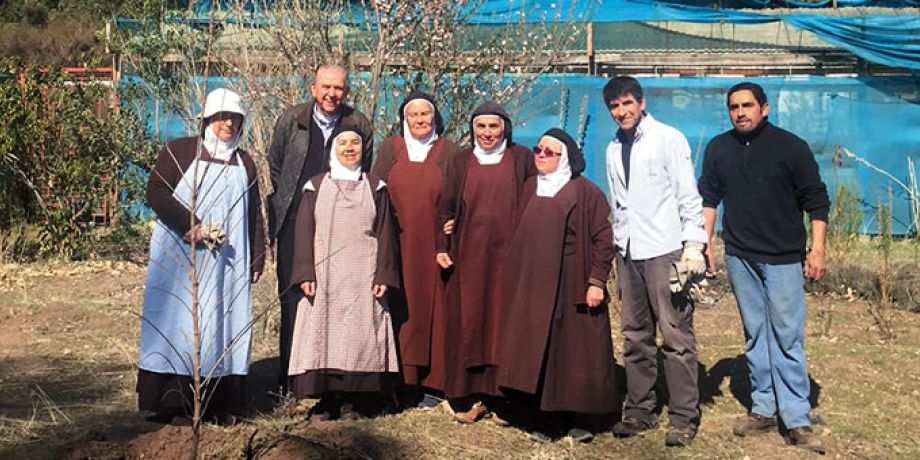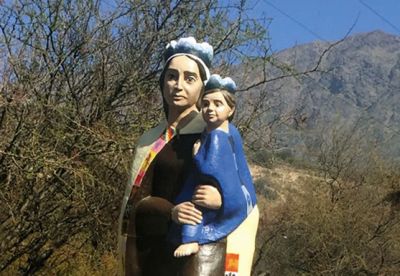
Guardian of the Waters and the Mountains
For the past seven years, I have traveled on Fridays to the Carmelite monastery located in a mountain canyon known as the Cajon del Maipo. I go there to celebrate Mass for the cloistered Discalced Carmelite Sisters. In the wintertime, as I drive to the monastery, I have often marveled at the beauty of the snowcapped mountains. But, not this winter! Why? Because there was no snow on them!

Sometimes, the Sisters let me use the Hermitage on the grounds to pray and reflect. From the Hermitage, I can look down at the River Maipo which flows from the Andes mountains on the border of Chile and Argentina and eventually empties out into the Pacific Ocean. The Sisters tell me that each year there is less water in the river. A recent report in the newspaper La Tercera verified the Sisters’ observations. The amount of water flowing in the river has been reduced by 25%. The central zone of Chile is experiencing the worst drought in decades. In Santiago, we rely on the rainfall of the winter months (June, July, August and September) to fill the reservoirs. The Cajon del Maipo is vitally important to the city of Santiago because of the two reservoirs which provide 60% of the city’s water. This winter, there has been a 72% deficit in the rainfall. Many experts have reported that the central valley of Chile is suffering the worst drought in 60 years. A new report released by the Natural Resources Defense Council and “Adapt Chile” find that Chile’s metropolitan region is facing an increasing water deficit that will worsen due to climate change.
The Sisters understand the impact of climate change and the dangers of drought. Since 2012, there have been fifteen forest fires near the monastery which have destroyed much of the native vegetation in the area. The worst occured in March 2014 when a fire raged near the monastery and burnt the homes of many of their neighbors. Miraculously, the fire stopped at the gates of the monastery although some sparks burned some of the vegetation on the grounds of the monastery. The dirt road which leads out to the main paved road was blocked by the flames. The Sisters managed to help forty people escape by descending down a ravine on the eastern edge of their property. As the Sisters and their neighbors made their way out to the main road they sang hymns. Unfortunately, one of their neighbors, Rigoberto Catalán, died in the fire.
Since the blessing ceremony, this unique shrine to Our Lady has become a place of pilgrimage.
That same year in September, a unique statue of Our Lady of Mount Carmel was inaugurated and blessed. In Spanish, the name of the statue is Virgen del Carmen, Madre y Reina de las Montañas y las Aguas (Virgin of Carmel Mother and Queen of the Mountains and the Waters). The statue measures 5.5 feet tall and was designed and built by two well known Chilean sculptors, Francisco Gazitúa and Angela Lieble. These artists wanted to signify the spiritual union between the original and the present inhabitants of the Cajon del Maipo. For that reason, Our Lady of Mount Carmel is clothed in the Carmelite habit, but the habit also include symbols of the original indigenous habitants of the Cajon del Maipo. The statue is located on the edge of the monastery and has a magnificent view of the River Maipo and the Andes mountains.

Since the blessing ceremony, this unique shrine to Our Lady has become a place of pilgrimage. Every September on the Saturday before the celebration of the feast of the Nativity of the Blessed Virgin Mary there is a special celebration which takes place near the statue of the Virgin of Carmel. It begins with a time of contemplation and prayer and is followed by the celebration of the Eucharist. After Mass, the sisters distribute soup and bread to the pilgrims.
During the month of November, which is the month of Mary in Chile, groups from various parishes come to the shrine to pray the Rosary. Visitors come frequently to the monastery to seek the prayers of the Sisters for their personal intentions. Many of them walk to the shrine, sit quietly and seek the intercession of the Virgin Mary.
A local guide, Daniel, whose family home was burnt in the fire of March 2014 and whose family lived on the grounds of the monastery for a year, leads tourists on a walk in the mountains. He likes to make a stop at the monastery and show the walkers the shrine. He gives them time to enjoy the splendid panoramic view. Normally, a couple of tourists will say a prayer before the statue of the Virgin of Carmel, Mother and Queen of the Mountains and the Waters.
Cardinal Ezzati approved a special prayer to this unique statue of the Virgin of Mount Carmel: “Most holy Virgin of Carmel, our mother, today we come to you as sons and daughters confident of your maternal love to invoke you as the Mother and Queen of the mountains and the Waters. Extend your robe of light and protect our mountain range from where the glaciers, rivers, wells and streams are born. Grant that the water, the precious gift of God the Father’s creation, continues to flow with power to purify, renew and bless us abundantly. Most Holy Mother, come to the heart of these mountains and reign always in them. Take us by the hand and lead us always toward your Son Jesus Christ, our Lord. Amen.”
Pope Francis reminds us in his Apostolic Exhortation Laudato Sí that “the entire material universe speaks of God’s love, His boundless affection for us. Soil, water, mountains: everything is, as it were, a caress of God.” (Laudato Sí no. 84) For that reason, the Holy Father calls to act in the defense of our Common Home. “Let ours be a time remembered for the awakening of a new reverence for life, the firm resolve to achieve sustainability, the quickening of the struggle for justice and peace, and the joyful celebration of life.” (Laudato Sí no. 2017)
After the fires, the local residents formed an organization called Salvemos Estero El Peumo (Let’s Save the Peumo Estuary). They are trying to create more consciousness about preventing forest fires. They also want to reforest the areas affected by the forest fires. The Sisters have joined their neighbors in efforts to reforest the area. Recently, the Columbans donated 20 trees to the monastery.
We agreed to donate the trees but it would have to be a joint effort. The Sisters would have to dig the holes for planting and two laymen who work with the Columbans would take care of the rest. Most of the trees to be planted were native Chilean trees (peumos and quillayes) which can survive and grow in areas where there is not abundant water. Several fruit trees were also included. Previous efforts to plant trees had failed because of the lack of irrigation. This time, the problem was solved when a drip system to ensure a more effective irrigation system was installed. If this effort is successful, the Columbans and the Carmelites will plant more trees. My hope is that soon I will be able to enjoy with so many others the beauty of the snow-capped mountains.
Columban Fr. Michael Hoban lives and Works in Chile.